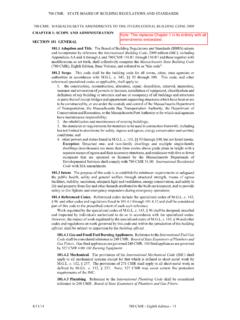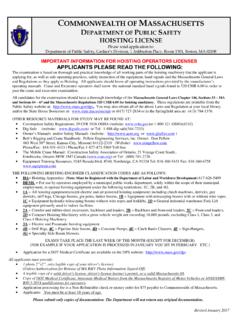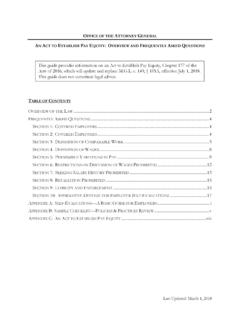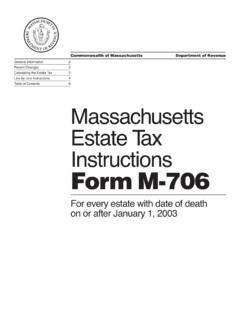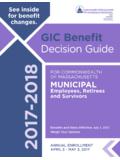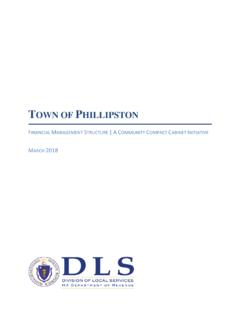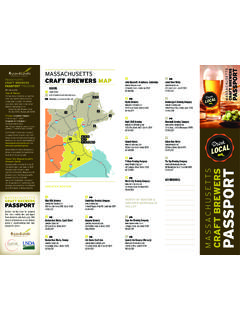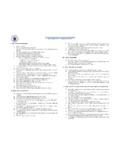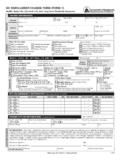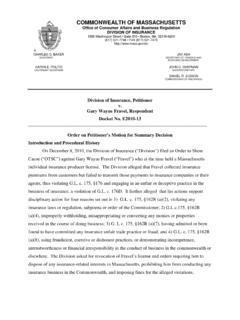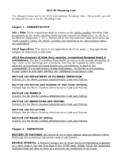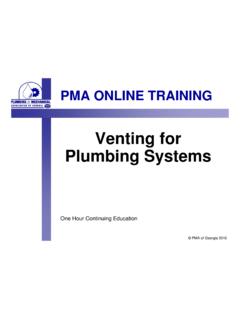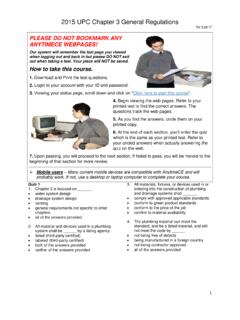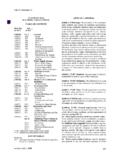Transcription of 248 CMR 10 - Mass.gov
1 248 CMR: BOARD OF STATE EXAMINERS OF PLUMBERS AND GAS FITTERS 248 CMR : UNIFORM STATE plumbing CODE Section : Scope and Jurisdiction : Basic Principles : Definitions : Testing and Safety : General Regulations : Materials : Joints and Connections : Traps and Cleanouts : Interceptors, Separators, and Holding Tanks : plumbing Fixtures : Hangers and Supports : Indirect Waste Piping : Piping and Treatment of Special Hazardous Wastes : Water Supply and the Water Distribution System : Sanitary Drainage System : Vents and Venting : Storm Drains : Hospital Fixtures : plumbing in Manufactured Homes and Construction Trailers : Public and Semi-public Swimming Pools : Boiler Blow-off Tank : Figures : Vacuum Drainage Systems : Scope and Jurisdiction (1) Scope.
2 248 CMR governs the requirements for the installation, alteration, removal, replacement, repair, or construction of all plumbing . (2) Jurisdiction. (a) Nothing in 248 CMR shall be construed as applying to: 1. refrigeration; 2. heating; 3. cooling; 4. ventilation or fire sprinkler systems beyond the point where a direct connection is made with the potable water distribution system. (b) Sanitary drains, storm water drains, hazardous waste drainage systems, dedicated systems, potable and non-potable water supply lines and other connections shall be subject to 248 CMR : Basic Principles Founding of Principles. 248 CMR is founded upon basic principles which hold that public health, environmental sanitation, and safety can only be achieved through properly designed, acceptably installed, and adequately maintained plumbing systems.
3 (1) Principle No. 1 - All Occupied Premises Must Have Potable Water. All habitable buildings must be provided with a supply of potable water. Such a water supply shall not be connected with unsafe or questionable water sources, nor shall it be subject to the hazards of backflow, backpressure, or back-siphonage. (2) Principle No. 2 - Adequate Water Required. plumbing fixtures, devices, and appurtenances must be supplied with water in sufficient volume and at pressures adequate to enable them to function properly under normal conditions of use. (3) Principle No. 3 - Hot Water Required. Hot water must be supplied in all habitable buildings for plumbing fixtures which utilize hot water for sanitary or hygienic purposes. mass . Register #1334 3/10/17 248 CMR: BOARD OF STATE EXAMINERS OF PLUMBERS AND GAS FITTERS : continued (4) Principle No.
4 4 - Water Conservation. plumbing must be designed and installed to meet the water conservation requirements of 248 CMR while using the minimum quantity of water necessary to function properly under normal conditions of use. (5) Principle No. 5 - Dangers of Explosion or Overheating. Devices and appliances for heating and storing water must be so designed and installed as to guard against dangers from explosion or overheating. (6) Principle No. 6 - Required plumbing Fixtures. (a) To meet the basic prerequisites of sanitation and personal hygiene each dwelling shall include the following: 1. At least one toilet; 2. At least one lavatory; 3. At least one kitchen style sink; 4. At least one bathtub or shower compartment or shower unit; 5. Laundry Facility Requirements.
5 A washing machine connection that consists of a piping arrangement that includes a cold water supply, hot water supply, and a sufficient drain connection shall be provided in conformance with the following: a. One and Two Family Dwelling. At least one washing machine connection in a common area accessible to all units. b. Multiple Dwellings. i. Non-elderly Housing. In multiple dwellings, other than dormitories, that are not restricted to the elderly, at least one washing machine connection for every ten dwelling units or fraction thereof that do not have a washing machine in the unit. ii. Elderly Housing. In housing that is restricted to the elderly, at least one washing machine connection for every 20 dwelling units or faction thereof that do not have a washing machine in the unit.
6 Iii. The washing machine connection shall be located so that each occupant in a dwelling has access to a washing machine that may be affixed to the washing machine connection. (b) All buildings and structures other than residential dwellings that are intended for occupancy shall be equipped with sufficient sanitary facilities as outlined in 248 CMR (c) plumbing fixtures must be constructed of durable, smooth, nonabsorbent, and corrosion resistant material and must be free of concealed fouling surfaces. (7) Principle No. 7 - Protection of Drainage Systems. The plumbing drainage system must be installed, designed, arranged, constructed, and maintained to protect against fouling, deposit of solids, and stoppages. Additionally, adequate cleanouts must be incorporated to ensure the system may be readily cleaned.
7 (8) Principle No. 8 - Durable Materials and Good Workmanship. The piping and other components of the plumbing system must be manufactured of durable material, free from defective workmanship, and designed and constructed to provide satisfactory service for its reasonable expected life. (9) Principle No. 9 - Need for Traps in the plumbing Drainage System. Every fixture directly connected to the drainage system must be equipped with a liquid-seal trap. The drainage and associated vent system must be designed to provide adequate circulation of air in and throughout all piping. Trap seals shall be protected from the dangers of siphonage, leakage, aspiration, momentum, oscillation, back pressure, evaporation, and capillary action under conditions of normal ordinary use.
8 (10) Principle No. 10 - Special Precautions for Oily and/or Flammable Liquid Wastes. Oily and/or flammable liquid wastes pose a public health and safety danger if not properly disposed of. Accordingly, all commercial buildings and garages which are used to store or repair motor vehicles must have separators installed to ensure that all oil, grease, and other flammable wastes are discharged before emptying into the building drainage system or other point of disposal. 248 CMR: BOARD OF STATE EXAMINERS OF PLUMBERS AND GAS FITTERS : continued (11) Principle No. 11 - Need for Venting in the plumbing System. Vent terminals shall extend to the outer air above the roof line and be installed to prohibit the possibility of vent obstruction and the return of sewage gases into the building.
9 (12) Principle No. 12 - plumbing Systems must Be Tested. The plumbing system must be subjected to such tests as mandated by 248 CMR to effectively disclose all leaks and defects in the work or the materials. (13) Principle No. 13 - Harmful Substances must Be Excluded from the plumbing System. No substance that will cause or exacerbate clogs or stoppages in pipes, produce explosive mixtures, destroy the pipes or their joints, or interfere unduly with the sewage disposal process shall enter the sanitary drainage system. Special waste water discharges containing such hazards must be collected and disposed of or treated prior to entering the sanitary drainage system. (14) Principle No. 14 - Need for Indirect Waste Piping in the plumbing Drainage System.
10 Indirect waste piping shall be provided to prevent backflow of sewage or the contamination of food, water, ice, sterile goods, and other similar products. When the potential of a backflow of sewage event is possible, the fixture, device, or appliance shall be connected indirectly with the building sanitary or storm drainage system. (15) Principle No. 15 - Light and Ventilation. No toilets, urinals, bathtubs, or shower facilities shall be installed into a new or renovated room, space, or compartment that does not incorporate proper illumination and mechanical exhaust to the exterior of the building. Principle No. 15 does not apply to the removal and replacement of existing fixtures. (16) Principle No. 16 - Need for Disposal of Sewage. All habitable buildings must be provided with a means of disposing of sewage.
